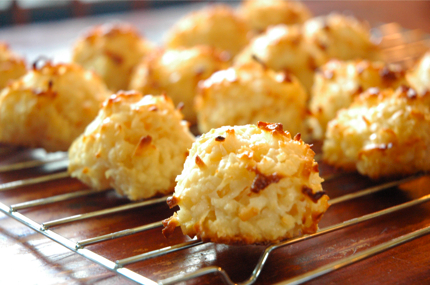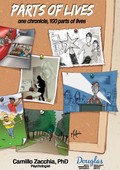Coconut. I suppose it is a legitimate thing to eat for some of you but I’d rather eat a handful of crickets.
When I was a teenager and feeling like I could eat something (i.e. always) I looked in my cupboard and saw a bag of coconut macaroon mix. I decided to bake a batch. Soon enough I put the first warm and chewy treat in my mouth. It was delicious so I had another…and another…and another. Within minutes I put the last of the macaroons in my mouth. I enjoyed every one of them. MMM!!
That was the last time I ever ate coconut! I didn’t get sick from my spree but those coconut macaroons stayed with me for some time before I finally fell asleep. That must’ve happened over forty years ago and I still can’t stomach even one flake on my dessert.
I’m sure you all have similar stories to tell. The first article I ever read in the field of psychology dealt with this very phenomenon: Conditioned taste aversion. I think it came from Psychology Today and was called ‘The Sauce Bearnaise Syndrome’ by Martin Seligman. The article discussed the topic of ‘preparedness’ in the development of some fears.
Preparedness refers to the fact that human beings are wired to learn some fears very quickly so as to keep us from doing dangerous things too often. Conditioned taste aversions develop quickly for this very reason. When you get sick from a food there are no second chances.
As I mentioned in my last post, things that are dangerous in a natural environment are feared instinctively, as is the case with spiders and snakes. Others, like conditioned taste aversions, require some experience but we are instinctively prepared to learn these very quickly.
I wrote about this phenomenon for my Metro column of August 12. It contains a second personal story. I invite you to also share your stories of conditioned taste aversions.
Let’s try those mushrooms again
(Source: Goûtons encore à ces champignons. Journal Métro, August 12, 2014)
(SVP, Voir plus bas pour la version Française)What if you were on a camping trip and ate some mushrooms you found in the forest? Imagine that you then spent the night convulsing with cold sweats in severe gastric distress. Luckily you survived to see the dawn. Whew!
What would you think? “Man! What the hell made me so sick? I wonder if it was those mushrooms. I think I’ll eat them again today just to make sure!” I doubt that. Chances are, once you’ve been sick after eating something, it takes a really long time to eat the same food again, if ever.
Such is the nature of conditioned taste aversion. Nature has prepared human beings to be scared of things that can kill us, and to learn of these dangers very quickly. In my last column I wrote of how some fears are more instinctive than others. Many people are scared of snakes despite never having been bit by one while few are scared of stoves despite many burns. This is because human beings are instinctively prepared to be afraid of dangerous things in the natural environments we evolved in – such as snakes, heights, closed spaces, etc.
Food works the same way. In a world of hunting and gathering, where the possibility of starvation is a real threat, human beings must try to eat just about anything that looks edible. Unfortunately not everything that looks edible actually is. This is where conditioned taste aversion comes in. We are wired in such a way that if we get sick once, we won’t try the same food twice. The smell, or even just the thought of, the same food will make us nauseous.
We all have stories to tell about foods we can’t stomach. If you have ever been to an Italian wedding, you know that they are an exercise in gluttony. When I was fourteen, after a magnificent feast, I was introduced to the twin wonders of the screwdriver and the open bar. I will spare you the details but I was also introduced that night to the wonders of the stomach’s defense against noxious substances such as obscene amounts of vodka and orange juice. Having thrown up the magnificent feast in several locations I spent the night asleep on my bathroom floor!
It took twenty years before I reacquired my taste for orange juice and I have yet to taste vodka since. It was my introduction to nature’s tendency to teach us quick lessons when it matters. Of course orange juice isn’t bad for you but wild mushrooms can be. The body doesn’t distinguish between noxious substances and ones simply there by association – such as when you have a gastric virus. When it comes to foods that make us sick, nature’s rule is a simple one: one strike and you’re out!
___________________________________________________________________
Voici la version Française:
Goûtons encore à ces champignons
Imaginons qu’en camping, vous avez mangé des champignons trouvés en forêt. Vous passez la nuit à vous tordre de douleur, à suer, en proie à des troubles gastriques. Heureusement, vous survivez jusqu’au matin. Ouf!
Que penseriez-vous? « Mais qu’est-ce qui m’a rendu(e) si malade? Je me demande si ça peut être ces champignons. Je vais en manger encore aujourd’hui, juste pour en avoir le cœur net. » J’en doute. Il y a de fortes possibilités qu’après avoir été malade à la suite de la consommation d’un aliment, il s’écoule beaucoup de temps avant que vous en mangiez de nouveau.
Telle est la nature des aversions alimentaires conditionnées. La nature a fait les humains de telle sorte qu’ils craignent les choses qui peuvent les tuer, et qu’ils connaissent ces dangers très rapidement. Dans ma dernière chronique, j’ai parlé de certaines peurs qui sont plus instinctives que d’autres. Bien des gens ont peur des serpents, même s’ils n’ont jamais été mordus, alors que peu d’individus craignent les cuisinières, même s’ils s’y sont brûlés plusieurs fois. C’est que les humains sont instinctivement faits pour craindre les choses dangereuses dans le milieu naturel où ils ont évolué, tels que les serpents, les hauteurs, les endroits clos, etc.
Il en va de même pour la nourriture. Dans un monde de chasse et de cueillette, où la possibilité de mourir de faim est une menace réelle, les humains doivent essayer de manger pratiquement tout ce qui semble comestible. Malheureusement, tout ce qui semble comestible ne l’est pas nécessairement. C’est là qu’entre en jeu l’aversion alimentaire. Nous sommes ainsi faits que si nous tombons malades une fois, nous ne remangerons pas de ce plat. L’odeur, ou même l’idée de ce plat, nous donnera la nausée.
Nous avons tous des anecdotes à propos d’aliments que nous ne digérons pas. Si vous avez déjà pris part à un mariage italien, vous savez qu’il y a de la gloutonnerie. Quand j’avais 14 ans, à une réception magnifique, j’ai été initié aux joies de la vodka-jus d’orange et du bar ouvert. Je vais vous épargner les détails, mais j’ai aussi connu ce soir-là le mécanisme de défense de l’estomac contre les quantités invraisemblables de vodka. Après avoir vomi un peu partout, j’ai passé la nuit sur le sol de ma salle de bains!
Il a fallu une vingtaine d’années avant que je reprenne plaisir à boire du jus d’orange, et je n’ai pas encore consommé d’autre vodka. La nature a tendance à nous enseigner rapidement des choses lorsqu’il le faut. Bien sûr, le jus d’orange n’est pas nocif, mais les champignons sauvages peuvent l’être. Le corps ne fait pas la distinction entre les produits nocifs et ceux que nous considérons comme tels, simplement par association, comme lorsqu’on attrape un virus gastrique. En ce qui concerne les aliments qui nous rendent malades, la règle de la nature est simple : tolérance zéro!
Tagged as conditioned taste aversions, Instinctive fears, preparedness.
Posted in Human nature.
Posted on 29 Jul 2014

